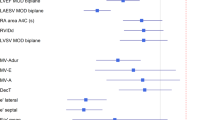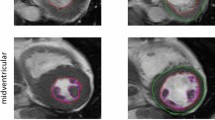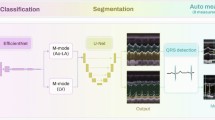Abstract
Machine learning techniques designed to recognize views and perform measurements are increasingly used to address the need for automation of the interpretation of echocardiographic images. The current study was designed to determine whether a recently developed and validated deep learning (DL) algorithm for automated measurements of echocardiographic parameters of left heart chamber size and function can improve the reproducibility and shorten the analysis time, compared to the conventional methodology. The DL algorithm trained to identify standard views and provide automated measurements of 20 standard parameters, was applied to images obtained in 12 randomly selected echocardiographic studies. The resultant measurements were reviewed and revised as necessary by 10 independent expert readers. The same readers also performed conventional manual measurements, which were averaged and used as the reference standard for the DL-assisted approach with and without the manual revisions. Inter-reader variability was quantified using coefficients of variation, which together with analysis times, were compared between the conventional reads and the DL-assisted approach. The fully automated DL measurements showed good agreement with the reference technique: Bland–Altman biases 0–14% of the measured values. Manual revisions resulted in only minor improvement in accuracy: biases 0–11%. This DL-assisted approach resulted in a 43% decrease in analysis time and less inter-reader variability than the conventional methodology: 2–3 times smaller coefficients of variation. In conclusion, DL-assisted approach to analysis of echocardiographic images can provide accurate left heart measurements with the added benefits of improved reproducibility and time savings, compared to conventional methodology.



Similar content being viewed by others
References
Fast J, Jacobs S (1991) Limits of reproducibility of cross-sectional echocardiographic measurements of left ventricular muscle mass. Int J Cardiol 31:213–216
Otterstad JE, Froeland G, St John Sutton M, Holme I (1997) Accuracy and reproducibility of biplane two-dimensional echocardiographic measurements of left ventricular dimensions and function. Eur Heart J 18:507–513
Jhang JS, Diamond JA, Phillips RA (1997) Interobserver variability of left ventricular measurements in a population of predominantly obese hypertensives using simultaneously acquired and displayed m-mode and 2-d cine echocardiography. Echocardiography 14:9–14
Thomson HL, Basmadjian AJ, Rainbird AJ, Razavi M, Avierinos JF, Pellikka PA et al (2001) Contrast echocardiography improves the accuracy and reproducibility of left ventricular remodeling measurements: a prospective, randomly assigned, blinded study. J Am Coll Cardiol 38:867–875
Baker G, Flack E, Hlavacek A, Chessa K, Fleming D, Scheurer M et al (2006) Variability and resource utilization of bedside three-dimensional echocardiographic quantitative measurements of left ventricular volume in congenital heart disease. Congenit Heart Dis 1:309–314
Moura LM, Ramos SF, Pinto FJ, Barros IM, Rocha-Goncalves F (2011) Analysis of variability and reproducibility of echocardiography measurements in valvular aortic valve stenosis. Rev Port Cardiol 30:25–33
Colan SD, Shirali G, Margossian R, Gallagher D, Altmann K, Canter C et al (2012) The ventricular volume variability study of the pediatric heart network: Study design and impact of beat averaging and variable type on the reproducibility of echocardiographic measurements in children with chronic dilated cardiomyopathy. J Am Soc Echocardiogr 25:842-854 e6
Lee CK, Margossian R, Sleeper LA, Canter CE, Chen S, Tani LY et al (2014) Variability of m-mode versus two-dimensional echocardiography measurements in children with dilated cardiomyopathy. Pediatr Cardiol 35:658–667
Madani A, Arnaout R, Mofrad M, Arnaout R (2018) Fast and accurate view classification of echocardiograms using deep learning. NPJ Digit Med. https://doi.org/10.1038/s41746-017-0013-1
Zhang J, Gajjala S, Agrawal P, Tison GH, Hallock LA, Beussink-Nelson L et al (2018) Fully automated echocardiogram interpretation in clinical practice. Circulation 138:1623–1635
Howard JP, Tan J, Shun-Shin MJ, Mahdi D, Nowbar AN, Arnold AD et al (2020) Improving ultrasound video classification: an evaluation of novel deep learning methods in echocardiography. J Med Artif Intell 3:4
Lang RM, Addetia K, Miyoshi T, Kebed K, Blitz A, Schreckenberg M et al (2021) Use of machine learning to improve echocardiographic image interpretation workflow: a disruptive paradigm change? J Am Soc Echocardiogr 34:443–445
Lang RM, Badano LP, Mor-Avi V, Afilalo J, Armstrong A, Ernande L et al (2015) Recommendations for cardiac chamber quantification by echocardiography in adults: An update from the american society of echocardiography and the european association of cardiovascular imaging. J Am Soc Echocardiogr 28:1-39 e14
Asch FM, Banchs J, Price R, Rigolin V, Thomas JD, Weissman NJ et al (2019) Need for a global definition of normative echo values-rationale and design of the world alliance of societies of echocardiography normal values study (WASE). J Am Soc Echocardiogr 32:157-162 e2
Mitchell C, Rahko PS, Blauwet LA, Canaday B, Finstuen JA, Foster MC et al (2019) Guidelines for performing a comprehensive transthoracic echocardiographic examination in adults: recommendations from the American Society of Echocardiography. J Am Soc Echocardiogr 32:1–64
Knackstedt C, Bekkers SC, Schummers G, Schreckenberg M, Muraru D, Badano LP et al (2015) Fully automated versus standard tracking of left ventricular ejection fraction and longitudinal strain: the fast-efs multicenter study. J Am Coll Cardiol 66:1456–1466
Acknowledgements
This work was supported by the American Society of Echocardiography (ASE) by allowing us to use the images collected in World Alliance of Societies of Echocardiography (WASE) Multicenter Study of Normal Values.
Funding
The authors have not disclosed any funding.
Author information
Authors and Affiliations
Contributions
VM performed statistical analysis and wrote the main manuscript text. AB, MS, AR, GS and DL developed the deep learning algorithm, analyzed the data and critically reviewed the manuscript. KA, KK, GS, LPB, JNK, PG-F, ACTD, AS, EST, ADP, WR, KOO performed the measurements and critically reviewed the manuscript. FMA and RML designed the study and critically reviewed the manuscript.
Corresponding author
Ethics declarations
Conflict of interest
The authors declare that they have no conflict of interest other than employment relationship with Tomtec for several authors.
Ethical approval
All procedures performed in studies involving human participants were in accordance with the ethical standards of the institutional and/or national research committee and with the 1964 Helsinki declaration and its later amendments or comparable ethical standards.
Informed consent
The study was approved by the Institutional Review Board.
Additional information
Publisher's Note
Springer Nature remains neutral with regard to jurisdictional claims in published maps and institutional affiliations.
Rights and permissions
Springer Nature or its licensor (e.g. a society or other partner) holds exclusive rights to this article under a publishing agreement with the author(s) or other rightsholder(s); author self-archiving of the accepted manuscript version of this article is solely governed by the terms of such publishing agreement and applicable law.
About this article
Cite this article
Mor-Avi, V., Blitz, A., Schreckenberg, M. et al. Deep learning assisted measurement of echocardiographic left heart parameters: improvement in interobserver variability and workflow efficiency. Int J Cardiovasc Imaging 39, 2507–2516 (2023). https://doi.org/10.1007/s10554-023-02960-5
Received:
Accepted:
Published:
Issue Date:
DOI: https://doi.org/10.1007/s10554-023-02960-5




